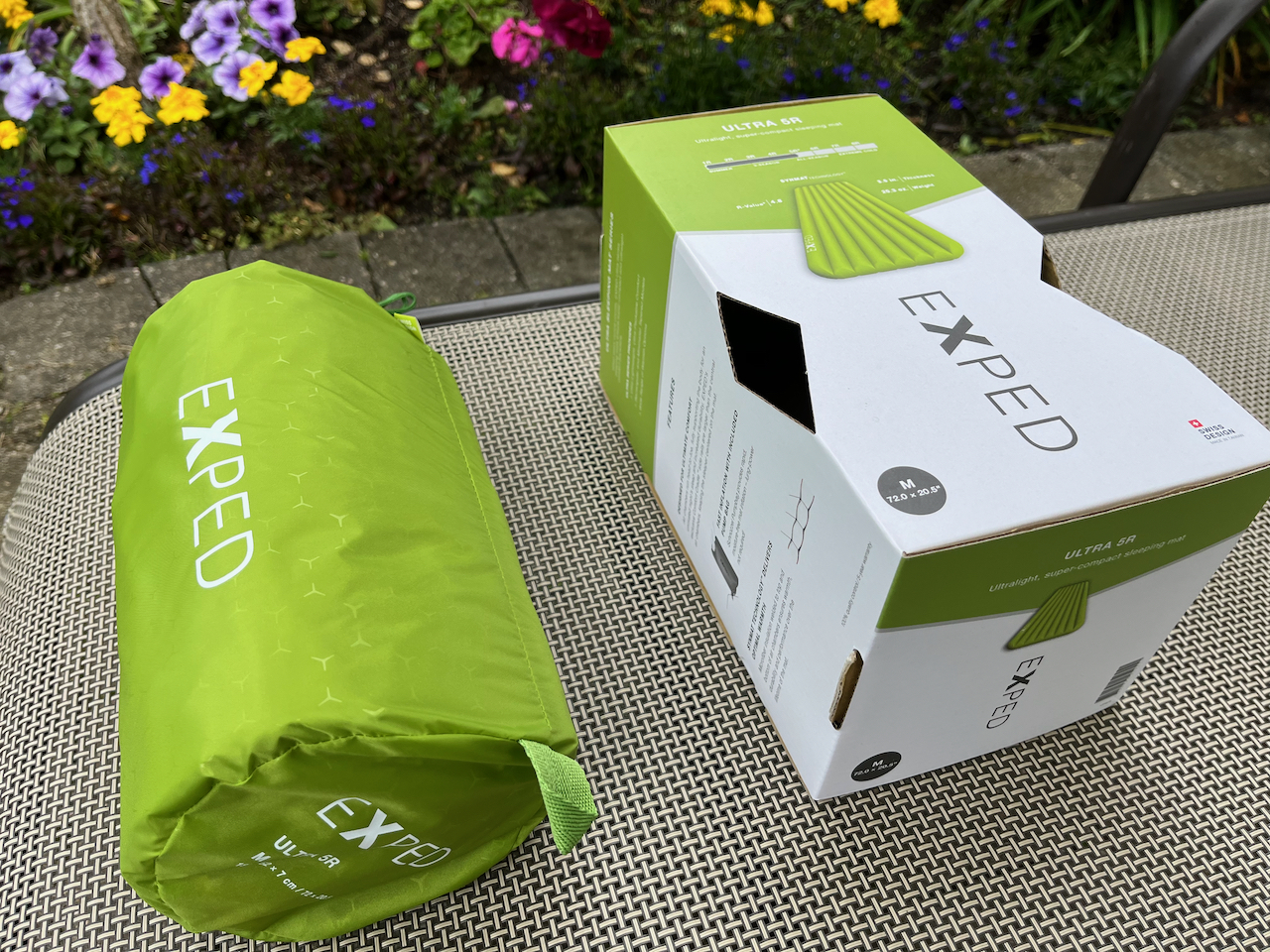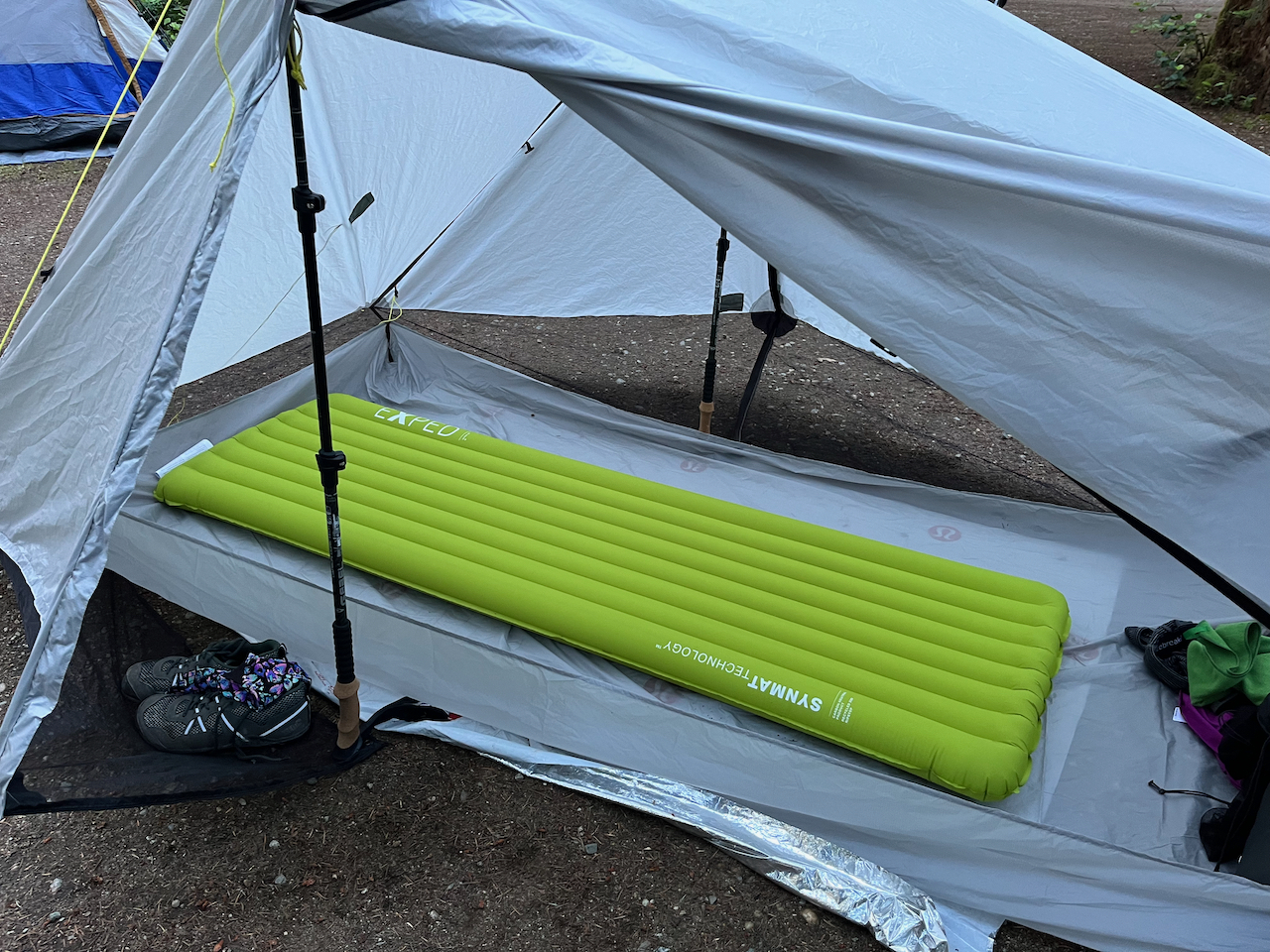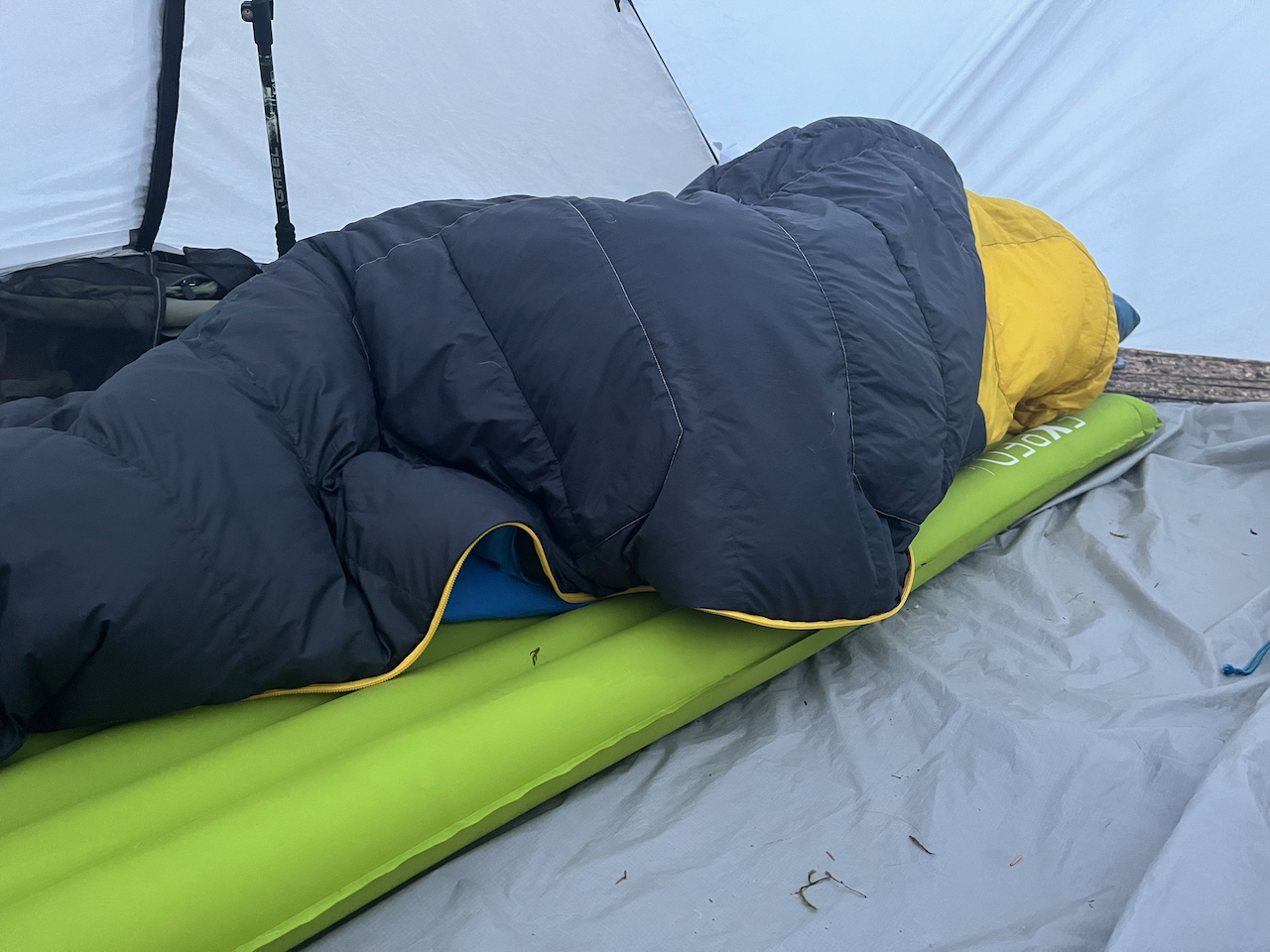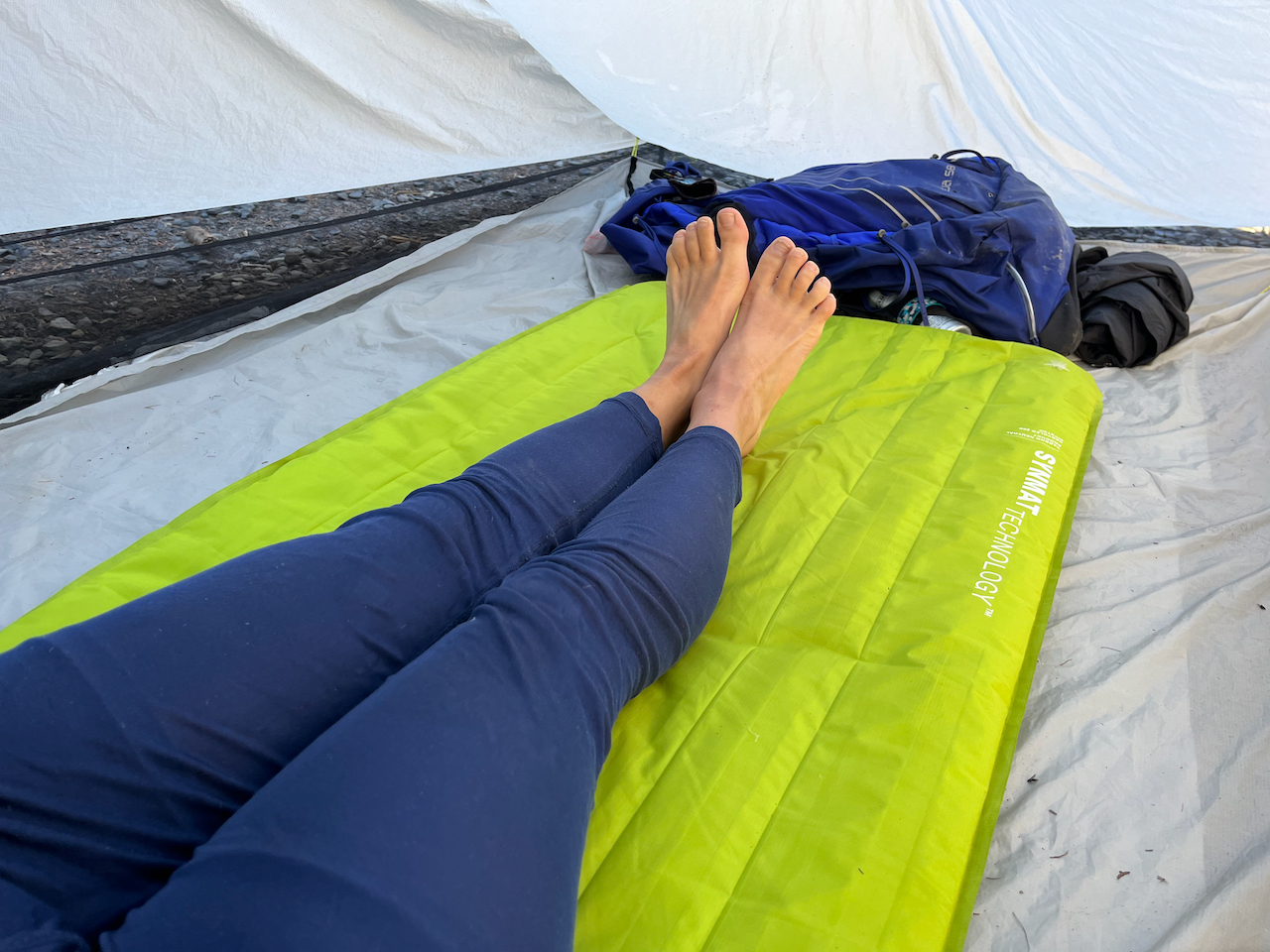EXPED Ultra 5R Sleeping Mat Review
EXPED has been designing and manufacturing innovative sleeping pads for over 20 years, but they’ve yet to become a recognized and sought-after brand with American backpackers. That is, perhaps, until now. EXPED’s new ULTRA series of sleeping mats offers adventurers a lightweight and compact inflatable mat with multiple options for shape, size, and warmth. This, plus the company’s commitment to high quality and sustainability, put them on the map in the USA.
EXPED Ultra 5R M At A Glance
MSRP: $189.95
R-Value: 4.8
Temperature Range: -4℉
Weight: 20 oz
Dimensions: 72” long, 20.5” wide, 3” high
Insulation: 160 g/m2 Texpedloft microfiber
Material: 20 D recycled ripstop polyester
Circumstances of Review
I tested the EXPED Ultra 5R Medium mat, receiving it at the beginning of my hiking season. I slept on it for about 20 nights throughout the summer on a wide variety of surfaces. Weather conditions were moderate to warm for the most part, so I wasn’t able to test its full capability as a potential four-season mat.
I’ve owned EXPED sleeping mats regularly for over 15 years, starting with the company’s innovative DownMat. For the past few years, I’ve slept on the comfortable and lightweight EXPED Synmat Hyperlite.
EXPED: Industry Innovators
Founded in Switzerland, EXPED started out as a distributor of iconic brands in the mid-eighties and transitioned to manufacturing its own goods in 1997. They released the industry’s first down-insulated backpacking sleeping mat, the DownMat, in 2001. Part of the process of developing the DownMat included designing the R-value system for testing the temperature rating of sleeping mats, which is now used industry-wide. In 2006 EXPED released the SynMat, the first micro-fiber insulated mat that welded the insulation to the inner fabric of the mat.
While still a relatively unknown brand in the United States (at least in the backpacking world—their self-inflating mattresses are fairly popular with car campers), EXPED now manufactures innovative and industry-leading tents, sleeping bags, sleeping mats, backpacks, and outdoor accessories for distribution across Europe and North America.
Features
Insulation & Comfort
EXPED’s Synmat Technology microfiber insulation is welded to the top and bottom of the air chambers, with a thick cushion of air between. This allows the insulation to stay put throughout its use and retain its warmth. The air chambers run head to toe which offer more natural-feeling support and better durability.
Sustainability
The main material of the Ultra mats is a 20 denier ripstop polyester made from recycled materials such as PET bottles and textile waste. The fabric is also tested and certified as free from substances that are harmful to human health. The insulation material is Bluesign certified, which means it meets the world’s strictest textile standard for environmental and consumer protection in textile production. EXPED also measures and fully offsets all global warming gases from both the manufacturing and shipping of its Ultra series sleeping mats.
Options
EXPED’s new Ultra series sleeping mats are available in a multitude of sizes and four levels of warmth: 1R, 3R, 5R, and 7R. Mummy and rectangle mats are available in medium, long, medium wide, and long wide. The 1R and 3R mats are also available in Duo size, which is a tapered double-wide mat for two sleepers.
Exped Ultra 5R Cons Pros
Warmth
My previous sleeping mat, the EXPED Synmat Hyperlite, had an R-value of 3.3, which kept me decently warm except on the coldest surfaces. Switching to a quilt this past year has made me hyper-aware of the warmth of my sleeping mat and led me to choose the Ultra 5R mat to test, which has an R-value of 4.8 I purposely brought both mats on a camping trip, sleeping on each mat on different nights. I could absolutely feel the difference in warmth. In fact, the Ultra 5R was almost too warm on many mid-summer nights. However, as we move into autumn, I know I’ll appreciate the extra warmth of the Ultra 5R.
Comfort
I find the EXPED mats incredibly comfortable and will often sleep better than on my mattress at home. As a side sleeper, I find the head-to-toe baffles cradle my body better than horizontal ones. The outer baffles are slightly larger, which helps to prevent the sleeper from rolling off the mat. The material used on the Ultra mats is smooth and comfortable against bare skin. The material is also grippier than previous models so the mat doesn’t slip around on the tent floor and your sleeping bag stays put too. Finally, the three-inch depth feels perfectly supportive when properly inflated and is absolute luxury in such a lightweight, durable and warm mat.
Inflation
The Ultra series sleeping mats have two valves: a one-way inflate valve and a deflate valve. The valves lie flush against the bottom of the mat. They are strong, durable, and easy to open and close. The inflate valve has a flap of fabric allowing air to be pumped in without any escaping. A toggle at the valve allows you to release a small amount of air if your mattress is too firm. I really appreciate the addition of a deflate valve for quick release in the morning.
Another pro of the inflation system is the included “Schnozzle” pump bag. I can inflate the mattress with about three pumps of the bag, greatly reducing the required effort before falling into bed. The bag is super lightweight and doubles as a dry bag. Using the inflation bag will also help prolong the life of your EXPED mat by reducing the amount of moisture, and thereby the possibility of mold, inside the mat.
Exped Ultra 5R Cons
Personally, I didn’t find any faults with my Ultra 5R. I also read through dozens of reviews by purchasers of the Ultra 1R, 3R, and 5R mats and found few complaints. Some reviewers commented about the awkwardness of learning to use the Schnozzle pump bag, but ultimately realized it was of benefit. My experience with the pump bag was that it’s a simple and effective tool, plus I really appreciate not having to waste my breath inflating my mattress at the end of a long day.
A few reviewers found their Ultra mat to be a little loud to sleep on, but the majority of reviewers found it to be quieter than most other insulated mats on the market (we’re looking at you, Therm-a-Rest!) I found the Ultra 5R plenty quiet and even a touch quieter than my previous Synmat Hyperlite.
The mummy versions of the Ultra mats are not currently sold at REI, and the model isn’t yet widely available with US outfitters. Thankfully, you can order all shapes, sizes, and warmths direct from expedusa.com.
Overall
I’ve always loved the comfort of my EXPED sleeping mats. With the release of the new ULTRA series mats, I have even more to love. The attention to detail, quality, and sustainability are key features of the redesigned lightweight backpacking mat, as well as the multitude of options for every adventure. I already anticipate purchasing the ULTRA 3R Mummy for my next summer thru-hike to complement my four-season ULTRA 5R.
An EXPED ULTRA sleeping mat is the obvious choice if you value comfort, quality, and sustainability.
Comparable Products
NEMO Tensor Ultralight Sleeping Pad
MSRP: $169.95 – $199.95
Big Agnes Insulated Air Core Ultra
MSRP: $99.95 – $139.95
Therm-a-Rest NeoAir XLite
MSRP: $179 – $229.95
The Exped Ultra 5R M was donated for purpose of review.
This website contains affiliate links, which means The Trek may receive a percentage of any product or service you purchase using the links in the articles or advertisements. The buyer pays the same price as they would otherwise, and your purchase helps to support The Trek's ongoing goal to serve you quality backpacking advice and information. Thanks for your support!
To learn more, please visit the About This Site page.

 ">
">








Comments 6
I’ve always heard good things about Exped mats from people I’ve encountered who had one, but over the last 4 years it seems, they’ve never been in stock anywhere (in the US). I think that is a large reason why they haven’t caught on here.
I switched to an exped mat a few years ago, and agree with many of the comments in this review. However, the big negative I found was that in the middle of an 18 day high altitude expedition, the dividing seam between two of the longitudinal baffles failed. As a result the pad had one large baffle in the middle of the pad. As a result I constantly rolled to one side or the other and off the pad. I fought this issue (and struggled for a decent night’s sleep) for a solid week. And my tent-mates didn’t appreciate me constantly rolling into their space! It’s worth noting that this situation can’t happen with pads like Therm-a-Rest which have baffles perpendicular to the long axis of the pad. I’m back to Therm-a-Rest and sleeping much better these days!
I had that happen to me too a few years ago with the Synmat Hyperlite. It was so awkward!
I talked with the Exped rep about that issue and he said that was something they worked hard on to negate with the new Ultra series.
I’ve had the Exped DownMat for at least 10 years. I tend to sleep cold and decided the extra weight was worth the weight. But then I switched to the NeoAir Xtherm, which was just as warm and lighter, and also MUCH NOISER.
This summer I decided to try the Exped Ultra. I intended to buy the 5R at REI, but I bought the 7R by mistake. But I decided to keep it, and I have to say, it is so comfortable, with 3.5 inches of height AND (down) insulation for R-7 AND a Medium Wide (saving the weight of the extra 6 inches you usually had to get in the Long version) AND it’s quiet! Now even my dogs are happy that I don’t disturb them for those nighttime calls of nature. 🙂
I’ve used it in the Colorado high country when it got down to 35 degree, using a quilt, and I stayed nice and warm. (I wear longjohns anyway, which also feel better when lying directly on the mat.)
One gigantic improvement over the old DownMat is the addition of the micro-deflate valve. The old DownMat forced you to pull the entire plug open, letting tons of air out before you could close it again (especially if you’re inside your tent lying on the mat!).
The biggest downside to the 7R is the down insulation. You really don’t want to add moist human breath, so you’re always supposed to use the Schnozzel. However, when adding just a small amount of air, I just blow into it anyway.
I also sleep with the valve on the top near my head so it is really easy to reach, if I need to let a little air out for comfort.
Finally: two of the photos show the mat completely inflated to the point of popping! People who have never used an inflatable pad may be unaware that this is NOT how you use it! I like to release enough air so my butt is not quite touching the floor. And then I check to see if my hip touches when I lie on my side. The first time I tried an inflatable, I’m ashamed to admit I didn’t know how to inflate it. I thought “This is not a comfortable pad!!” Sigh.
(PS–I still use the old DownMat for car/truck camping. When combined with my old rectangle cotton bag, it is super comfortable. And I can use my Coleman battery-operated blower to inflate it in about 10 seconds.)
Holly crap these mats are noisy. Don’t buy them. People from three camp sites over will throw rocks at you. My wife threatened to divorce me if I used it a second time.